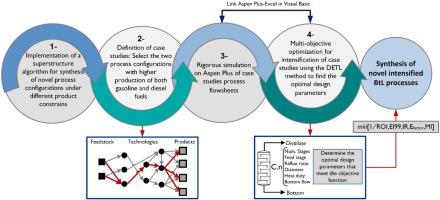Chemical Engineering and Processing: Process Intensification ( IF 4.3 ) Pub Date : 2021-02-11 , DOI: 10.1016/j.cep.2021.108327 Paola Ibarra-Gonzalez , Ben-Guang Rong , Juan Gabriel Segovia-Hernández , Eduardo Sánchez-Ramírez

|
The transport sector increasing energy demand has encouraged the search for alternative technologies for biofuels production with lower manufacturing costs and higher process efficiency and environmental performance. Lignocellulosic biofuels are equivalents to petroleum products and can be adapted to meet the properties requirements of current engines. However, their major disadvantages are the high production costs and the lack of infrastructure. In this work, the focus is on the implementation of a multi-objective optimization methodology for synthesis of novel intensified biomass-to-liquid (BtL) technologies with lower environmental impact and costs, as well as higher process safety and efficiency. A novel optimization methodology is applied to two process configurations that were synthesized in a previous work [1], in which the evaluation of a BtL processing superstructure under different economic constraints and product profiles scenarios was performed. From the configurations, the two case studies with higher production of both gasoline and diesel were selected for this work. For the synthesis of intensified BtL technologies, the optimal separation units’ design parameters that meet the combination of economic, safety and environmental indexes, and two green chemistry metrics were selected. By applying the methodology, the optimal intensified process presents a higher return on investment of 22 (%/y) compared to 18 (%/y) for the base case flowsheet.
中文翻译:

用于过程合成和强化的多目标优化方法:基于气化的生物质转化为运输燃料
运输部门对能源的需求不断增长,促使人们寻求生物燃料生产的替代技术,以降低制造成本,提高过程效率和环境绩效。木质纤维素生物燃料等同于石油产品,可以适应当前发动机的性能要求。然而,它们的主要缺点是高生产成本和缺乏基础设施。在这项工作中,重点是实施多目标优化方法,以合成具有较低环境影响和成本以及更高的过程安全性和效率的新型强化生物质到液体(BtL)技术。一种新颖的优化方法应用于先前工作中综合的两个过程配置[1],在其中评估了在不同经济限制和产品概况情况下的BtL加工上层建筑。从配置中,为这项工作选择了两个汽油和柴油产量更高的案例研究。为了合成增强的BtL技术,选择了满足经济,安全和环境指标相结合的最佳分离装置的设计参数,并选择了两个绿色化学指标。通过应用该方法,与基本案例流程图的18(%/ y)相比,最佳强化流程的投资回报率更高,为22(%/ y)。这项工作选择了两个汽油和柴油产量更高的案例研究。为了合成增强的BtL技术,选择了满足经济,安全和环境指标相结合的最佳分离装置的设计参数,并选择了两个绿色化学指标。通过应用该方法,与基本案例流程图的18(%/ y)相比,最佳强化流程的投资回报率更高,为22(%/ y)。这项工作选择了两个汽油和柴油产量更高的案例研究。为了合成增强的BtL技术,选择了满足经济,安全和环境指标相结合的最佳分离装置的设计参数,并选择了两个绿色化学指标。通过应用该方法,与基本案例流程图的18(%/ y)相比,最佳强化流程的投资回报率更高,为22(%/ y)。


























 京公网安备 11010802027423号
京公网安备 11010802027423号